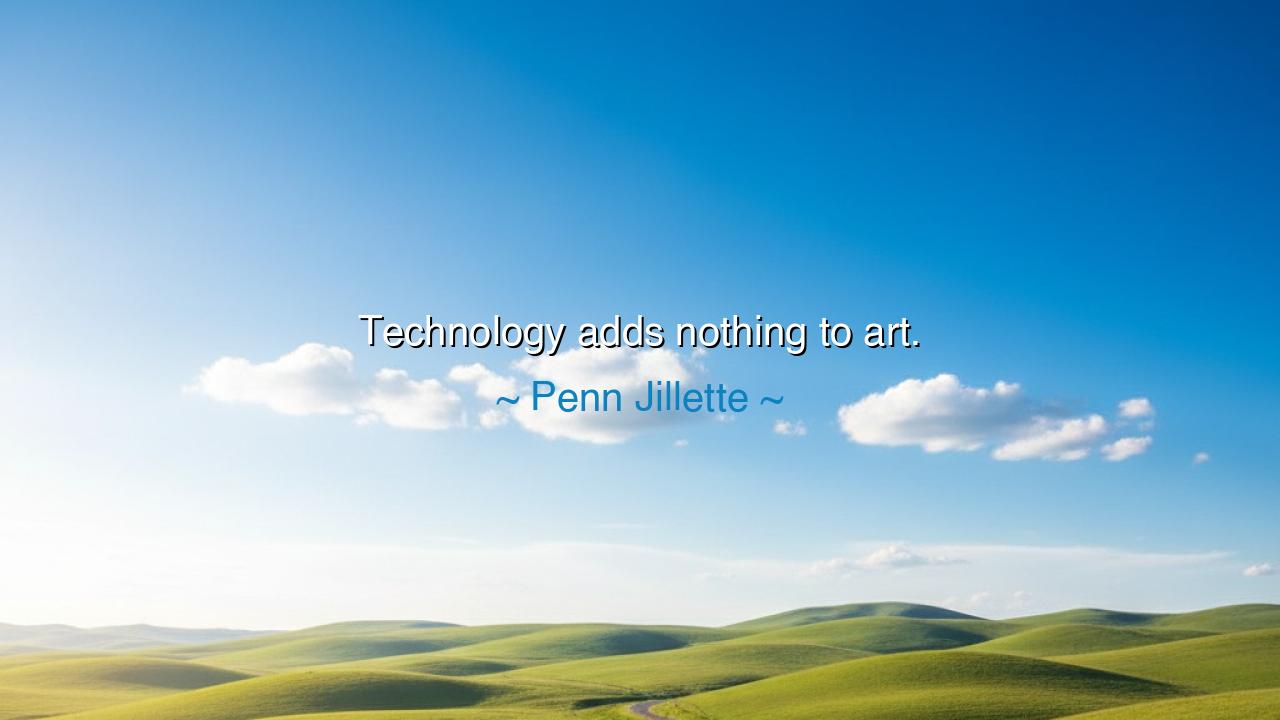
Technology adds nothing to art.






Penn Jillette, master of illusion and voice of bold truths, once spoke a line as sharp as a chisel: “Technology adds nothing to art.” In these words, he unveils a truth that has echoed through the ages — that art is not born from the tools, but from the soul. A brush does not make a painting, nor a lyre a song; it is the hand that guides, the heart that imagines, the spirit that dares to speak. Technology, with all its brilliance, is but a vessel. The fire of creation does not dwell in circuits or steel, but in the human breath that gives them meaning.
In ancient caves, long before chisels or pigments refined, our ancestors took the simplest of tools — charcoal, ochre, and rock walls — and left behind images of hunts and spirits. These were not lesser works for their lack of sophistication. Indeed, they strike us still with their raw power, for the soul of the artist burned bright in every line. From those primal scratches to the marble of Michelangelo, from Homer’s recited verses to Shakespeare’s quill, the lesson is constant: the greatness of art lies not in the means but in the mind that wields them.
Consider the story of Beethoven, deaf yet unbroken. When silence encased his world, when no technology of hearing could restore the sound, he still composed symphonies that shook the heavens. With nothing but imagination and the strength of memory, he created the Ninth Symphony, a work that speaks across centuries. This is the truth of Jillette’s words — that tools cannot create beauty where none exists, nor silence the genius that already lives within.
But let us not mistake his saying. Technology may serve, but it cannot create. It can carry the voice of the singer across oceans, but it cannot place the song in her heart. It can sculpt illusions with lights and machines, but without vision it is only noise and flash. The danger lies in worshipping the tool as though it were the source. Just as a sword without a warrior is a useless piece of iron, so is technology without the spirit of artistry — hollow, empty, and forgotten.
The ancients, too, faced this temptation. In Rome, vast amphitheaters were built, with marvels of engineering to astonish the crowd. But when the spirit of performance waned, when spectacle replaced story, the people grew numb, craving ever more extremes. The stone arches and mechanics of the Colosseum could not save the decline of Roman entertainment, for art had fled. The lesson remains: invention cannot replace inspiration.
Thus, Penn Jillette’s wisdom calls to us: treasure the inner flame above the outer tool. Cultivate vision, courage, and voice. Use technology as servant, not master. For when the tool is praised above the artist, the song grows hollow, and the painting is but decoration without soul. Yet when the artist leads, even the simplest tool — a word, a gesture, a line upon paper — becomes eternal.
So, let the listener act with resolve: do not wait for the finest tools before creating. Begin with what you have. Sing with your own voice, even if the world offers no stage. Draw with your hand, even if no canvas is grand. Let art spring forth from your spirit, and let technology, if it comes, serve only to carry it farther. For the essence of beauty lies not in what is built, but in what is born within. And thus we pass down this teaching: that the soul, not the machine, is the true fountain of creation.






AAdministratorAdministrator
Welcome, honored guests. Please leave a comment, we will respond soon